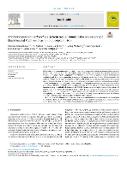Antibiotic-resistant Escherichia coli from treated municipal wastewaters and Black-headed Gull nestlings on the recipient river

Author
Masarikova, Martina
Sukkar, Iva
Jamborova, Ivana
Publication date
2024Published in
One HealthVolume / Issue
19 (December)ISBN / ISSN
ISSN: 2352-7714ISBN / ISSN
eISSN: 2352-7714Metadata
Show full item recordCollections
This publication has a published version with DOI 10.1016/j.onehlt.2024.100901
Abstract
Wastewaters belong among the most important sources of environmental pollution, including antibiotic-resistant bacteria. The aim of the study was to evaluate treated wastewaters as a possible transmission pathway for bacterial colonisation of gulls occupying the receiving river. A collection of antibiotic-resistant Escherichia coli originating both from treated municipal wastewaters discharged to the river Svratka (Czech Republic) and nestlings of Black-headed Gull (Chroicocephalus ridibundus) living 35 km downstream of the outlet was obtained using selective cultivation. Isolates were further characterised by various phenotyping and genotyping methods. From a total of 670 E. coli isolates (450 from effluents, 220 from gulls), 86 isolates (41 from effluents, 45 from gulls) showed identical antibiotic resistance phenotype and genotype and were further analysed for clonal relatedness using pulsed-field gel electrophoresis (PFGE). Despite the overall high diversity of the isolates, 21 isolates from both sources showed similar PFGE profiles. Isolates belonging to epidemiologically important sequence types (ST131, 15 isolates; ST23, three isolates) were subjected to whole-genome sequencing. Subsequent phylogenetic analysis did not reveal any close clonal relationship between the isolates from the effluents and gulls' nestlings with the closest strains showing 90 SNPs difference. Although our study did not provide direct evidence of transmission of antibiotic-resistant E. coli to wild gulls via treated wastewaters, we observed gull chicks as carriers of diverse multi-resistant E. coli, including high-risk clones, posing risk of further bacterial contamination of the surrounding environment.
Keywords
Enterobacterales, Environment, Whole-genome sequencing, Wild birds
Permanent link
https://hdl.handle.net/20.500.14178/2778License
Full text of this result is licensed under: Creative Commons Uveďte původ 4.0 International




